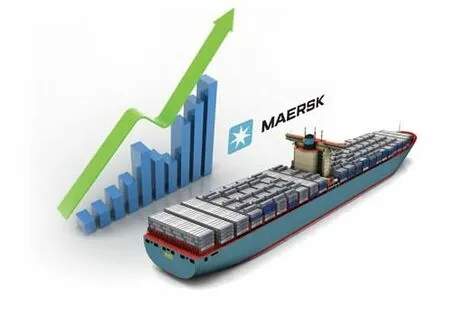Maersk Line:Galloping into the Distance
By Luo Dan & Jiang Nanchun

On May 13, Maersk group released its firstquarter financial statement data, which indicates that Maersk line keeps the trend of strong performance, with a profit of $714 million(compared with $454 million of last year), recording a growth of 57% over the same period of last year;and an actual profit of $710 million (compared with$366 million of last year), recording a growth of 94%over the same period of last year. When many other companies are suffering from excess capacity and low freight, how Maersk has achieved this growth?
Since SorenSkou took over Maersk line during early 2012, Maersk line has been making earnings growth for three consecutive years, including operating profit of$2.2 billion in 2014. For SorenSkou,cut down the cost where all places can cut, maximum use of the company's huge network, including the internal network and external network through partners extension of the old and the new alliance.
Most importantly, SorenSkou is observing the status of the company from a practical perspective. He believed that the era of global container freight volume growth with double-digit had gone forever. Those shipping enterprises that are still living in the past era are too optimistic about the future, and have not got well prepared for the current situation of low profit.
Rumor has it that Maersk line recently ordered 4+7 ultra large container ships of 20,000 TEU with Daewoo shipbuilding. SorenSkou said that Maersk will continue to order ships, with different models to meet the needs of operation of different trade routes. When asked whether he had expected to provide 25,000 TEU to the global shipping market, SorenSkou said that it would be possible in the future, but not realistic at this stage.
The news says that Maersk line initiates new shipbuilding project again four years later. According to Bloomberg news, Mr Andersen, the Chief Executive of Maersk group said that the company will mainly order smaller vessel.
As the expansion of Panama Canal will be completed next year, the third phase lock can receive ships of 13,500 TEU, and later on 14,000 TEU ships. Thus,Maersk is likely making some preparation to embrace the widened Panama Canal with the order of a batch of 13,000 ~ 14,000 TEU ships.
Secondly, providing feeder vessels for a large number of 3E new ships. As the Panama Canal expansion project will be completed next year, the old “panamax ships”of 5000 TEU are likely to be scrapped in advance.This is what many owners are facing currently. For example, the route from the North Sea to the Baltic Sea can absorb more 5000 TEU ships, but since the route is within ECA, as a result, these ships are facing sulfur tax control. Accordingly, Maersk is likely to customize a new ship type for the route, such as ships with the best speed, cleaner energy, and possibly with dual fuel as the propulsion power.
SorenSkou said that a key point of understanding the container shipping industry is to understand that the current growth is much lower than before. From 2012 to 2014, the average annual growth rate of container output is less than 4%, much lower than that before the financial crisis, in the many years before the crisis,the increase rate of volume had beenmore than 8%for each year, or even a double-digit growth rate. As what we have seen, it is hard to believe that the good old time will come back. The shipping industry must learn to survive under the situation of low growth and persistent excess capacity. Most of the industries are currently striving to live on under such circumstances.For some reasons, there is a culture in the shipping industry which believes that except that ships' loading rate reaches 99.5%, we don't believe that profit will be possible. But we must learn to live underthe condition of excess capacity.
In addition to actively pushing forward the trend of larger vessels, Maersk has gotten special attention in the past few years by changing its relationship with Mediterranean shipping company from competitors to coalition partners. In the second half of 2011, the two companies were caught in the vicious price competition,leading to both of them being the losers. In June 2013,Maersk, Mediterranean Shipping and CGM announced to establish P3 alliance. In June of 2014, China's antitrust regulators rejected P3 alliance. Subsequently,Maersk and Mediterranean Shipping established 2M alliance and achieved a successful turn around. The two companies have become close partners on the world's three main east-west trade routes.
SorenSkou pointed out that the most critical force of promoting the service quality is perhaps our network management. We can adjust the network very quickly to maintain a high level of space utilization. Our asset turnover rate is rising continuously and per container fuel consumption is constantly reducing.

